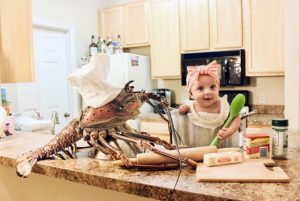
Florida spiny lobster season occurs every year from August 6th-March 31st! Grab some delicious bugs while the season is open and enjoy some fresh from Florida seafood. Read the rest of the blog for information on Florida spiny lobster rules and regulations, the significance of the recreational and commercial fishery, life history information and tips how to cook spiny lobster tail.
If you enjoyed our post and learned something today, we would love to hear your input via this survey! The questionnaire is super short and helps us do our job. There’s also a box where you can tell us what other content you would like us to cover. Thanks!
Recreational Spiny Lobster Rules and Regulations
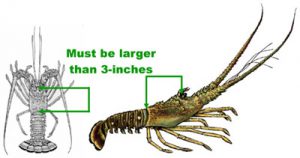
Divers with a current saltwater fishing and lobster license may harvest their 6 per person daily bag limit from August 6th until 11:59 pm on March 31st. Spiny lobsters have a minimum size limit of a carapace length over 3” with egg bearing females excluded from harvest. This carapace measurement is taken from the hard portion between the rostral horns extending to the back of the head segment. If your gauge hangs over the back, let that little guy go till next year!
Lobster must be measured in the water and if legal, brought back to the dock whole. Total boat bag limits are calculated by number of properly licensed or exempt individuals who are actively harvesting lobster and not just sitting on the boat! NO spearing or methods involving penetrating or crushing the exoskeleton may be used to harvest spiny lobster. The most common approved methods of harvesting lobsters in Florida are net with tickle stick, snare or grabbing them by hand. Before grabbing a lobster from its hole, check to see if there are other critters in there, moray eels inhabit the same spots as spiny lobsters and can deliver a painful bite! Check out this video on how to catch a spiny lobster!
A Day In The Life
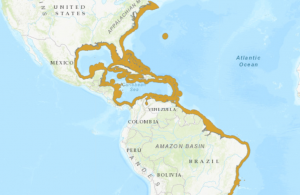
The range of the Caribbean spiny lobster (Pannulirus argus) extends from the Northeast United States down to Brazil occurring in the Atlantic Ocean, Caribbean Sea and the Gulf of Mexico. Lobsters are primarily nocturnal and typically are found in rocky bottom and coral reef habitats as adults Juvenile lobster usually inhabit mangrove roots and sea grass beds and then migrate offshore when older.
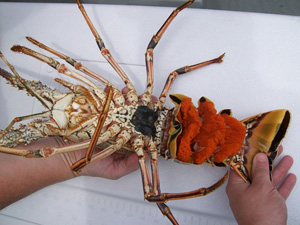
Spiny lobsters can grow up to 15lbs and live an estimated 15+ years. Aging crustaceans has traditionally been difficult because as the creatures grow, they molt, completely replacing their old shell and resume life in a entirely new exoskeleton. As spiny lobsters get grow the frequency in which they shed their shell reduces from multiple times a year to perhaps once a year or fewer depending on size of the bug. There is new research on using growth bands on gastric mills, internal structures found in the lobster used to grind food, to get a more accurate age estimation. In Florida, a typical 3” carapace length lobster is approximately 2 years old with females becoming sexually reproductive with a carapace length of 2.75-3”. Lobsters spawn in the Florida Keys from March to August while in the Caribbean have been documented to spawn year long. Female lobsters release between 230,000 – 2.6 million larvae after about 3 weeks of holding their eggs, number of larvae spawned directly correlates to the size of the lobster.
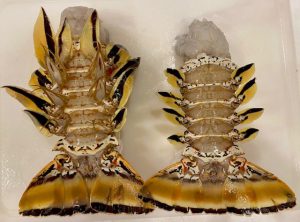
The amount of time Caribbean spiny lobsters remain larvae is staggering! In a laboratory study it was found that the pelagic larval duration (time spent floating in the ocean currents) was 174 ± 22 days! Researchers also found that the spiny lobster underwent 10 distinct morphological life stages and larvae molted 18-21 times before they were in their recognizable juvenile form. A long pelagic larval duration means that larvae released from one reef can travel thousands of miles away in ocean currents before settling as juvenile lobsters! As a result, most of the lobsters found in the United States were spawned somewhere else in the Caribbean. This complex life history makes managing the the spiny lobster difficult with conservation, regulation and research efforts occurring throughout many countries in the Atlantic and Caribbean.
Lobsters are scavengers and will eat pretty much anything; however, some of their favorite prey items are clams, snails, urchins and crabs. Some predators of the spiny lobster include fish (grouper, snapper etc.), sharks, rays, skates, octopus, sea turtles, moral eels and of course humans.
But wait! There are more species of lobster living in Florida that have different rules and regulations! Learn more about them on by clicking the link to our blog below:
Year-Round Lobster Season in Southwest Florida?!
Commercial importance
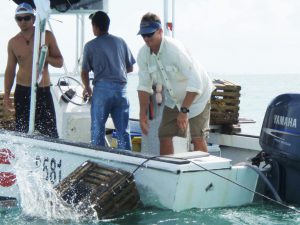
The Caribbean spiny lobster is a highly valued commercially harvested species. The Food and Agriculture Organization (FAO) of the United Nations reported the value of the spiny lobster fishery in the Western Central Atlantic and Caribbean at $400 million to $1 billion dollars depending on the year. In 2018 the Florida commercial dockside value of spiny lobster was $45 million and the second most valued species behind shrimp (FWC). The majority of the ~6 million pounds landed by commercial fishermen in Florida are caught in lobster traps (FWC).
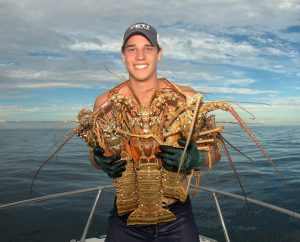
Lobster in Southwest Florida
Spiny lobsters are encountered less frequently in the waters off Southwest Florida when compared to the Florida Keys or the Southeast however can be regularly caught. Off the coast of Southwest Florida, spiny lobsters inhabit small ledges and hard bottom in depths between 60-120ft. A ledge with high relief can house Goliath Grouper, a predator of spiny lobster and most lobsters tend to be found in smaller potholes known as “swiss cheese” or “red grouper bottom” as those environments add to increased protection. It seems like the frequency of bumping into lobster increases during the summer months as wind and wave conditions are more flat allowing new spots to be found on the depth finder. If you find some lobster out of season, note the spot as some may stay nearby for months. As a result of reduced diver pressure and the vast expanse of the West Florida shelf, when you find these needle-in-the-haystack lobster, they are often larger than the average Southern bug averaging 3-7lbs!
Check out how to catch spiny lobster in this video!
Table Fare
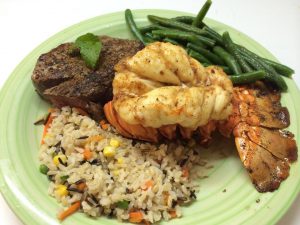
The Caribbean spiny lobster makes for some great meals! The meat from the tail is very versatile and can be fried, grilled, baked or boiled. A favorite way I prepare spiny lobster is to shear the top of the tail with scissors and scoop the meat out. I then place the meat on top the shell to be baked in a preheated oven at 350 degrees for 20 minutes. Moreover, periodically baste the tail meat with butter seasoned with garlic and paprika to ensure for a moist flavorful experience. This method results in an impressive display and equally remarkable meal. The shell of the lobster allows the chef to become creative with a wide array of cooking methods from boiling in the shell, halving the shell using it as a container to hold the meat in butter or extracting the meat out cooking it on top.
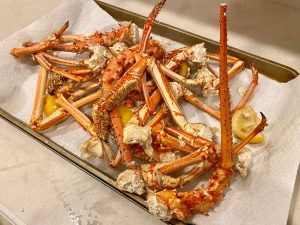
Although these lobster don’t have claws like their cousin the American lobster (Homarus americanus), large spiny lobsters may have antennae and legs with enough substance to warrant breaking out the pliers and nutcrackers. When preparing spiny lobster legs and antennae I prefer boiling them like a traditional crab or crawfish boil using a seasoning pouch, lemon, onion, corn and potatoes. The delicious meat from the extremities has a finer consistency and reminds me more of crab than the tail portion of the lobster.
Storing lobster
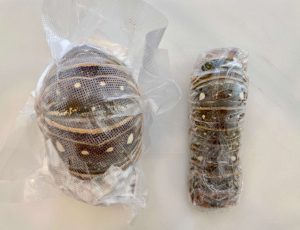
Spiny lobster store very well in the freezer and even after a year can taste as fresh as the week you caught them. The shell of the tail provides an extra level of protection against freezer burn however breaking out the vacuum bags or saran wrap ensures for a great future meal. Tip: when vacuum sealing tails, fold a few paper towels and place them under the tail so that sharp points of the carapace don’t puncture the bag releasing the vacuum.
Click the word Youtube, Instagram or Facebook below to check out the Collier County Sea Grant Youtube Channel, Instagram page and Facebook page for more educational posts and videos!
References:
https://myfwc.com/research/saltwater/crustaceans/lobster/facts/
https://www.researchgate.net/publication/317003887_Age_determination_in_crustaceans_a_review
https://academic.oup.com/jcb/article/28/2/306/2548278
https://www.fisheries.noaa.gov/species/caribbean-spiny-lobster
http://www.fao.org/fi/static-media/MeetingDocuments/WECAFC/WECAFC2019/17/Ref.35e.pdf
https://www.iucnredlist.org/species/169976/6697254
https://floridakeys.noaa.gov/whatsnew/around/2016/lobster.html
 0
0
